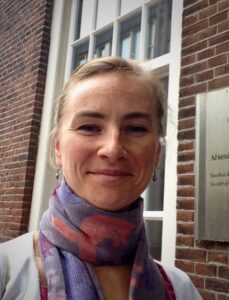Urban Studies Community
‘Whatever issue art addresses, art in public space puts us all in equal position and reminds of our values as a community’
Geplaatst in NewsFlash, Uncategorized.
Meet Ksenia Fedorova

Urbanization does not only involve the physical. Many processes are intangible and thus require insight about human relations and critical approaches to them. A spectrum of new challenges is introduced by increasing penetration of digital technologies in the city, the effects of which are not always predictable. Dr. Ksenia Fedorova, an author, lecturer in our Urban Studies programme and scholar, discussed her perspective on the intersecting domains of art, science and media technologies in relation to urban life.
The roots of Ksenia’s interests are in epistemology, art, media and cultural theories. Her area of expertise includes examination of perception of oneself, the other, the environment, and how technologies mediate and modify these relations. Throughout her academic life she has observed and practiced a multiplicity of perspectives on these and other subjects, which include philosophical, psychoanalytic, media theoretical and aesthetic lenses.
Talking about her involvement with the field of Urban Studies, Ksenia recalls her work as a curator at the National Centre for Contemporary Art in Yekaterinburg, Russia 14 years ago. “We did not have an exhibition space, so the whole city became a ground to experiment with. This meant a lot of thinking about public space, its histories and potentialities”. The projects were done not only for the citizens, but with the citizens as active participants shaping the city in the way they wanted to see it.
Last year, Ksenia published a book called Tactics of Interfacing: Encoding Affect in Art and Technology (MIT Press, 2020). One of the chapters focuses on proprioception, a sense of the body’s relation to place and space. She explored it through various artistic projects that employ locative media and augmented reality, showing how new and unexpected layers of meaning can be discovered in familiar surroundings with technologies that became part of the everyday life. In our conversation she stressed, that creative usage of technology in public space can also be politically provocative. An example of that can be media facades and the messages transmitted through them to many people simultaneously. One such project mentioned by Ksenia, “Countdown Machine”, was done in 2016 in Hong Kong as part of the art program on the façade of one of the tallest business towers in the city. The project presented a ticking clock showing the countdown of days until China would take over Hong Kong – a highly political statement that led to the closure of the whole program. It also prompted a debate about the potential self-censorship of cultural institutions that decide what can and cannot be shown.
Ksenia explains that artists have the “capacity to address the public’s collective imageries”, they can create images and aesthetic experiences to pinpoint “critical zones that need rethinking” (e.g. issues of urban air pollution addressed in projects like Beatriz da Costa’s “Pigeon Blog”, where she sent pigeons to collect air quality data in low-income districts that no one researched; or issues of national borders in projects like Raphael Lozano-Hammer’s “Border Tuner” that enabled communication between members of Chicano population in El Paso, Texas and across the border in Mexico). Whatever issue art addresses, much of the time it is up to the observer to interpret the message. But done in public space, it puts us all in equal position and reminds of our values as a community.
Lastly, Ksenia’s work demonstrates the importance of critical approach to the increasing usage of sensing and tracking technologies that allegedly make our cities “smarter”. What is missing in this dream of pervasive manageability and control, she argues, is in principle not trackable and quantifiable – the multitude of social relations and individual affective attitudes to places that are crucial for the healthy and innovative development of urban fabric.
Check out Ksenia’s latest book: Fedorova, Ksenia. Tactics of Interfacing: Encoding Affect in Art and Technology. Cambridge, MA: MIT Press, 2020.
Read more about the ”Countdown Machine”: Park, Lisa SoYoung, & Benayoun, Maurice. (2020). A Cautionary Tale of Urban Media Art: Media-Bait, Planned Censorship and Its Repercussions. Leonardo, 53(2), 135-144.
